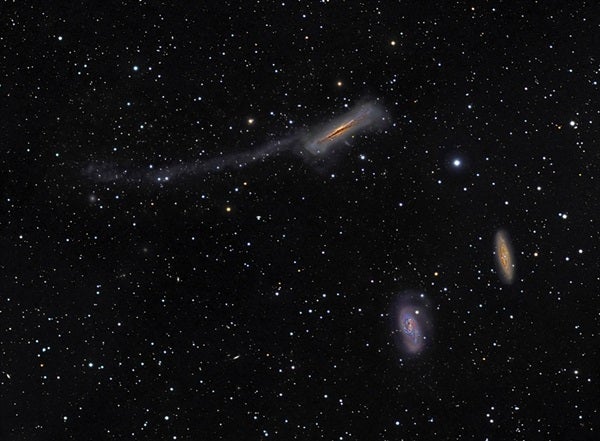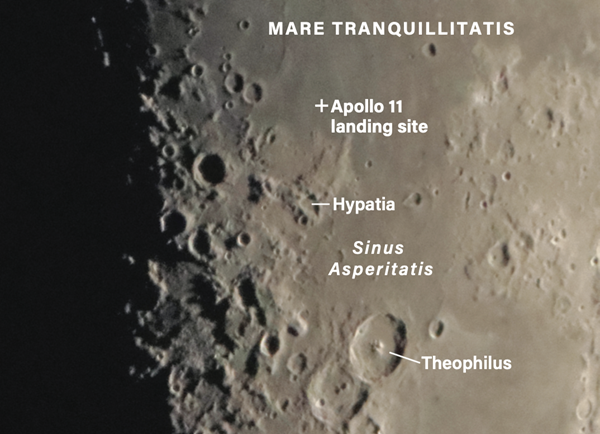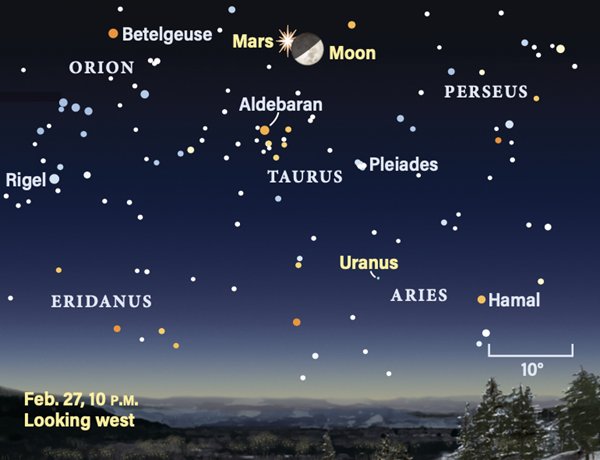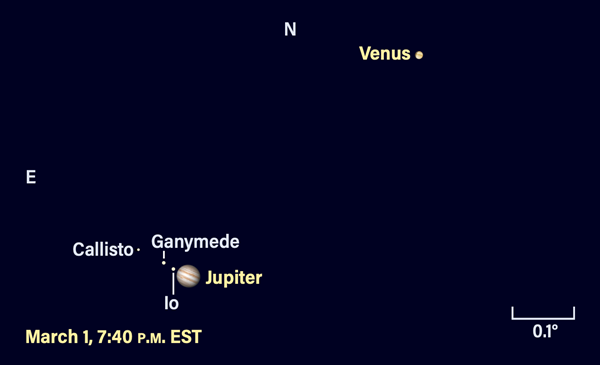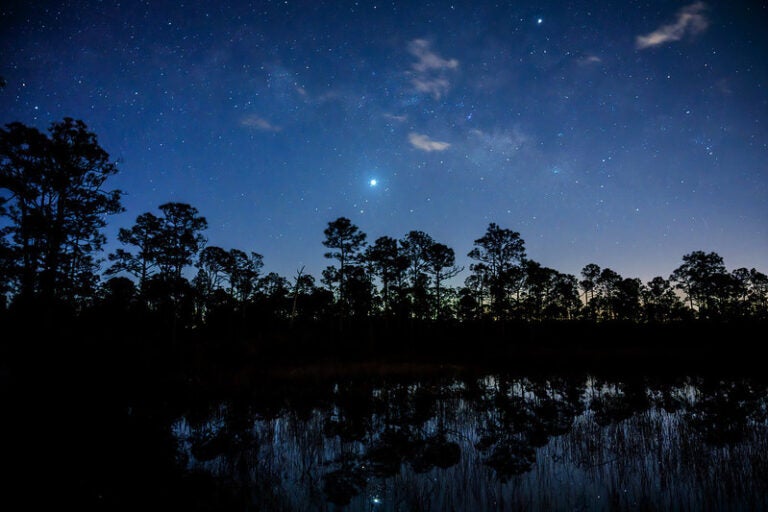Friday, February 24
The asteroid 2 Pallas sits nearly due west of Sirius in the evening sky tonight. Canis Major is about as high as he’ll get above the horizon around 8 P.M. local time; the Big Dog sits in the south, easy to find with his blazing nose star at magnitude –1.4.
Center that bright luminary in binoculars or a telescope and slowly scan west. Pallas sits just under 3° from Sirius, about halfway between that star and Mirzam (Beta [β] Canis Majoris). The main-belt world glows close to 8th magnitude, brighter than many of the field stars around it. Look about 1° northeast, and you’ll see a loose grouping of magnitude 7 to 9 of stars shaped like a tiny, upside-down dipper. Pallas will pass through this group in two days’ time, offering an excellent opportunity to see the asteroid’s shift against the background sky in about an hour. Sketch out or photograph the position of these stars now, then watch as our tiny target advances on and through them over the next two days.
Sunrise: 6:41 A.M.
Sunset: 5:46 P.M.
Moonrise: 9:07 A.M.
Moonset: 11:10 P.M.
Moon Phase: Waxing crescent (25%)
*Times for sunrise, sunset, moonrise, and moonset are given in local time from 40° N 90° W. The Moon’s illumination is given at 12 P.M. local time from the same location.
Saturday, February 25
The Moon passes 1.3° north of Uranus at 8 A.M. EST. An hour after sunset this evening, the two are already nearly 6.5° apart, with the Moon standing close to 4th-magnitude Botein (Delta [δ] Arietis) in the Ram.
Uranus lies southwest of the Moon, almost perfectly halfway between Sigma (σ) and Pi (π) Arietis. At magnitude 5.8, you’ll likely need binoculars or a small telescope to spot the distant ice giant. Its tiny disk spans just 4″, thanks to the planet’s immense distance from Earth (currently some 20 times the average Earth-Sun separation).
Although the Moon is waxing, see if you can spot nearby M33, which sits in far western Triangulum. You’ll find this 6th-magnitude spiral galaxy some 4.3° west-northwest of Alpha (α) Trianguli. M33 is part of our Local Group of galaxies and is third largest after Andromeda (M31) and the Milky Way. It spans just over a degree on its longer axis, and just under a degree on its shorter one. This galaxy is also called the Pinwheel Galaxy.
Sunrise: 6:39 A.M.
Sunset: 5:47 P.M.
Moonrise: 9:35 A.M.
Moonset: —
Moon Phase: Waxing crescent (34%)
Sunday, February 26
In his March column, Stephen James O’Meara discusses the way sunlight can sometimes flood into the lunar crater Hypatia. Located in the Sea of Tranquillity close to the Apollo 11 landing site, Hypatia’s eastern wall features a “breach” that allows light to spill across the crater floor when the Sun strikes the lunar surface at a particular angle.
Tonight at 8:26 P.M. EST (which corresponds to 1h26m UT on February 26), conditions are predicted to be just right to see that ray of sunlight appear on the crater’s otherwise darkened floor. Set up your telescope earlier than this and center in on Hypatia, then watch patiently. Can you see the ray appear?
If you’re still looking for a challenge, see if you can zero in on the three small craters named for the crewmembers of Apollo 11 — Armstrong, Aldrin, and Collins — which sit near their landing site to the north of Hypatia.
Sunrise: 6:38 A.M.
Sunset: 5:49 P.M.
Moonrise: 10:05 A.M.
Moonset: 12:18 A.M.
Moon Phase: Waxing crescent (44%)
Monday, February 27
First Quarter Moon occurs at early this morning at 3:06 A.M. EST. Later, just as the clock strikes midnight, our satellite passes 1.1° north of Mars in Taurus.
A few hours earlier, look for the Bull slowly sinking in the west. Around 11 P.M. EST, Mars and the Moon lie 5° below Elnath, the tip of one horn; the pair are just over 1° apart, with Mars to the Moon’s upper left (southeast). You should be able to catch the magnitude 0.3 Red Planet through binoculars or a telescope. Its disk has shrunk following its December close pass as Mars and Earth continue to separate, now appearing 8″ wide.
Even with the moonlight, you should be spot a few stars in the Pleiades (M45), the open cluster about 18° to the lower right (southwest) of the Moon. This young grouping of suns covers about 110′ and is a treat to observe through binoculars or at low magnification with your telescope — you might even find it beneficial to use your finder scope.
Taurus approaches the horizon as the hours tick by, though the constellation remains high enough that our satellite passing due north of Mars is visible across the country.
Sunrise: 6:36 A.M.
Sunset: 5:50 P.M.
Moonrise: 10:42 A.M.
Moonset: 1:25 A.M.
Moon Phase: Waxing gibbous (54%)
Tuesday, February 28
The large constellation Virgo dominates the eastern sky overnight, reaching an altitude of about 40° by local midnight. That’s the perfect time to seek out Porrima (Gamma [γ] Virginis), one of the sky’s best double stars.
Sometimes also called Arich, Porrima forms the join in the Y-shaped constellation of the Maiden. It shines at magnitude 2.7 when viewed with the naked eye; when split apart into its two components, you’ll see a magnitude 3.65 and magnitude 3.56 star. The two look nearly identical to the human eye, both shining yellow-white — though one may appear slightly more yellowish than the other. Because the stars’ orbits around each other are highly elliptical, they aren’t always easy to split. Luckily, they are currently separable with even a small telescope, so get out there and give it a try.
Sunrise: 6:35 A.M.
Sunset: 5:51 P.M.
Moonrise: 11:25 A.M.
Moonset: 2:26 A.M.
Moon Phase: Waxing gibbous (64%)
Wednesday, March 1
The month of March kicks off with a bang as Venus and Jupiter meet in the sky. Tonight is the best time to view the event in the U.S., even though the true moment of conjunction occurs early tomorrow (when the two planets have set for U.S. observers.)
At sunset, Venus is still about 30° high in the west. The bright magnitude –3.9 planet should pop out of the twilight shortly after the Sun sinks below the horizon. Jupiter lies just 30′ to the southeast (upper left); at magnitude –2.1 it’s still bright enough to appear soon after sunset. See how long it takes for you to spot the gas giant’s glow in the sky.
Focus in on the pair with binoculars or, better yet, a telescope to glean more detail. Venus appears 12″ across and is 86 percent lit. Here, Jupiter really shows its might — although it is farther from Earth, its much larger girth means it appears 34″ across, nearly three times as wide as Venus. Also visible are three of its four Galilean moons: From nearest to farthest, Io, Ganymede, and Callisto all lie strung out to the planet’s east. Europa is currently behind the planet in an occultation and won’t make its way out of Jupiter’s long, dark shadow before the system sets for the eastern and middle U.S., though West Coast observers will see it reappear about 15′ east of the planet’s limb around 7:10 PST.
Sunrise: 6:33 A.M.
Sunset: 5:52 P.M.
Moonrise: 12:14 P.M.
Moonset: 3:23 A.M.
Moon Phase: Waxing gibbous (73%)
Thursday, March 2
Venus officially passes 0.5° north of Jupiter at 6 A.M. EST, when both are no longer above the horizon. Instead, you can catch them again after sunset, now with Venus shining less than 1° to the upper right (northwest) of Jupiter. They’re still close enough to catch in the same field of view of a telescope, and all four of Jupiter’s moons are visible tonight. Io sits alone west of the planet, while Europa (closest), Ganymede, and Callisto (farthest) lie east.
After you’ve looked your fill, glance far to the upper left (east-southeast) in the sky and you’ll spot unmissable Sirius, the nose of Canis Major. Slide back to the lower right (west) of that bright star a bit, and you’ll be smack dab in the middle of the constellation Lepus the Hare. Situated directly south of Orion, Lepus has two named stars, Arneb (its magnitude 2.6 alpha star) and Nihal (magnitude 2.9, the beta star). But the constellation features several other, fainter stars that create the vague outline of a rabbit beneath the familiar hourglass of Orion’s body.
Sunrise: 6:32 A.M.
Sunset: 5:53 PM
Moonrise: 1:09 P.M.
Moonset: 4:12 A.M.
Moon Phase: Waxing gibbous (80%)
Friday, March 3
The Moon reaches apogee, the farthest point from Earth in its orbit, at 1 P.M. EST. At that time, our satellite will sit 252,207 miles (405,888 kilometers) away.
Leo the Lion is climbing up into the eastern sky after sunset this evening. Give him a few hours to rise above the horizon haze, then turn your telescope toward his hind end to locate the beautiful Leo Triplet of galaxies.
This trio is located about halfway between Theta (θ) and Iota (ι) Leonis, making them relatively easy to find with your telescope. The grouping consists of three spirals: M65, M66, and NGC 3628, all roughly 35 million light-years away. M66 is brightest by a smidge, coming in at magnitude 8.9; M65 is magnitude 9.3, while NGC 3628 is magnitude 9.5. Both M65 and M66 will show some signs of their spiral structure through increasing apertures, but NGC 3628 is edge-on, looking long, skinny, and relatively featureless. NGC 3628 is the farthest east; using this galaxy as a starting point, M65 lies 35′ southwest of NGC 3628 and M66 is 35′ south of NGC 3628.
The Moon should be far enough away that a moderate-sized telescope will pick up these targets. If you’re having trouble, though, wait a few days, until the Moon has passed through this region of the sky and rises after the Lion. That will afford darker skies for those with smaller instruments to enjoy these galaxies.
Sunrise: 6:30 A.M.
Sunset: 5:54 P.M.
Moonrise: 2:09 P.M.
Moonset: 4:54 A.M.
Moon Phase: Waxing gibbous (87%)

